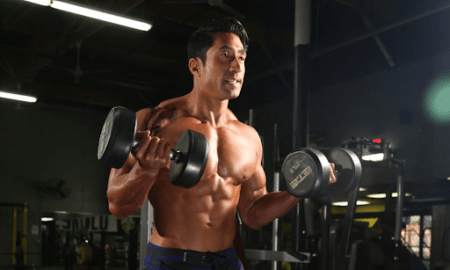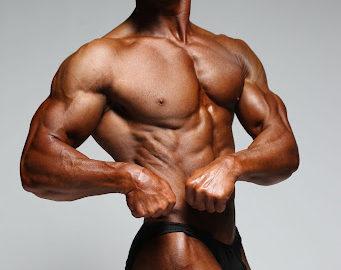
Q: I understand that the low and intermediate motor units fire first during a set, but surely those fibers can be recruited and exhausted more efficiently in the semistretch position, without the need for full-range reps. Then after a brief pause, you continue with more X Reps for fast-twitch recruitment—it would be like rest/pause X Reps. In the semistretch position there’s more cross-bridge contact, so you should be able to completely eliminate full-range reps, which would make the exercises safer. After all, we seldom use full-range movements in everyday activities. What do you think?
A: You’re right, the actin and myosin pairings are optimized for max force output in the semistretch position, so partial reps in that zone may be all you need for complete development.
We do a full-range movement, or very close to it, because we believe it better strengthens the muscle at all positions of contractability and also fortifies tendons and ligaments in those positions so you’re not predisposed to weakness or injury there. Nevertheless, I’ve discussed the mass-building benefits of X-only sets in interviews and in our e-books. In our latest, X-traordinary Muscle-Building Workouts, we discuss forced X Reps, which is a very heavy X-only set done with help from your partner for more stretch overload on the muscle. It’s a very effective shock method for jolting new growth, but it must be used sparingly—it’s severe. Also, William Litz’s feature on Power X-Rep Partials in the November ’07 IM included interesting observations and applications of the X-only training he and his clients are using.
One thing to consider is that bundles of fibers fire throughout the stroke of an exercise. In theory you could miss some by limiting the range to the bottom third. Science says that different angles can activate different fibers—say, by using leg extensions as opposed to squats. So it may be that the top end of a press can recruit a few different fibers from the bottom area. Is it enough to make a difference, or does it happen at all? Let me know how your partial-reps-only experiment goes. Your results will add to our data.
Q: You say that a grip slightly narrower than shoulder width hits both heads of the biceps best. That seems to contradict Larry Scott’s advice. In his book Loaded Guns, he says that after researching anatomy books he discovered that a wide grip activated both heads of the biceps. Also, in your Heavy/Light Program, why is heavy work included on light days if the central nervous system needs a week to recover? Couldn’t I just do all heavy exercises on heavy days and all light exercises on light days?
A: Magnetic resonance imaging shows that a grip slightly narrower than shoulder width hits both heads of the biceps equally, so it’s the most efficient grip. If you move in very narrow, you hit more outer head; if you move your hands out wide, you hit more inner head. But in all cases you activate both heads; it’s just that with a wide grip the inner head is prioritized and with a very narrow grip the outer head is prioritized. That’s why concentration curls are said to develop peak—because the exercise simulates a very narrow grip that focuses on the outer head, the section responsible for more height when the biceps is flexed.
Jonathan and I have found that to be true in our biceps development. Not to contradict Larry, but guys with superior neuromuscular efficiency in the biceps can probably get extreme development in both heads no matter what the grip. He’s not wrong—you do activate both heads with a wide grip; however, the inner head gets the brunt of the work. It’s the old in-for-out/out-for-in rule. Use a close, or in, grip or foot stance to hit the outer area of the target muscle; use a wide, or out, grip or stance to hit the inner area of the target muscle.
As for the structure of our heavy/light program, we considered nervous system recovery as well as mind-set when we were constructing it. Doing all heavy work at one workout and then all light work at the next was an option; however, we reasoned that it’s probably best to do a heavy workout for the first bodypart, then go light for the second and so on to avoid overtaxing recovery with an all-heavy day. Going heavy on chest, lats, triceps and abs in one workout is not conducive to our current phase of training, which is fall and winter/strength and size, but if you’re highly motivated and have good recovery ability, it might work better for you, along the lines of Eric Broser’s Power/Rep Range/Shock.
Q: I read the last chapter in your e-book X-traordinary Muscle-Building Workouts, “Stretch-Overload Research,” and found it intriguing, to say the least. The [animal] study that produced a 300 percent mass increase with one month of muscle-stretch work speaks volumes for the importance of that type of training and stretching. But I’m confused after reading some reports in bodybuilding magazines. Some say to stretch between sets, while others say that stretching weakens the muscles. Which is right? When should I stretch—or should I? By the way, XMBW is my most prized e-book—what a great concept; so many great programs. Thank you!
A: We appreciate the kind words regarding our newest e-book. Stress variation in the gym is a major mass producer, so an e-book with an arsenal of different printable workouts is something we saw as necessary. As for your question, you see a lot of bodybuilders stretching the target muscle between sets. No question that muscle stretch is important for extreme growth, as it increases the anabolic environment in muscle tissue—from anabolic hormone release to possible fiber splitting to satellite cell activation; however, stretching between sets is not the way to go, according to the latest studies. Here’s why, from respected bodybuilding researcher Jerry Brainum:
Several recent studies have indicated pretraining stretching as a cause of muscle-strength loss, notably a loss of strength varying from 4.5 to 28 percent when stretching is done before heavy weight training. The strength loss is most often attributed to a drop in muscle tension. Other studies show that stretching interferes with the neural control of muscles, leading to weaker contractions.
You want the muscle to be as strong as possible on your work sets, so don’t weaken the muscle by stretching it between them. A better size-building strategy is to stretch the target muscle at the end of a bodypart workout. You can do freehand static stretching or static holds on stretch-position exercises—like holding dumbbells at the bottom of incline curls done on a low incline bench.
By the way, stretch-position exercises are different animals when done dynamically (with movement) as opposed to static-hold stretches. Russian research shows that stretch-overload exercises done with resistance can actually heighten muscle-fiber activation, mostly due to the myotatic reflex, an emergency reaction by the nervous system for preventing injury. The nervous system senses overload in the stretch position, where the muscle is vulnerable, and jacks up fiber recruitment to prevent injury. That increases muscle-fiber recruitment rather than diminishing it, as with static stretches. And more fiber activation means more mass stimulation.
That’s why I suggest including stretch-position exercises for every muscle—flyes for pecs, stiff-legged deadlifts for hamstrings, incline curls for biceps, etc.—as in the 3D Positions-of-Flexion workouts. They will give you the benefit of accelerating anabolism with the unique stimulus of stretch overload. But always do your big compound, or midrange, exercise first just to be safe.
Remember, you want to be able to generate as much force as possible during your midrange exercises: bench presses, squats, etc. So warm up thoroughly—no extended static stretching—and then blast out your sets with power. Don’t forget the X-Rep partials on the last set for even more force generation and semistretch overload, which is a perfect transition to stretch-overload exercises.
Incidentally, Jay Cutler uses a lot of stretch-position exercises, stretch-overload techniques and semistretch activation (what we call Double-X Overload) in his workouts. It may be one of the key reasons he’s taken his physique to the next level and won the Mr. Olympia twice.
Editor’s note: Steve Holman is the author of many bodybuilding best-sellers, including 10-Week Size Surge (see the book-ad section that begins on page 230). For information on the POF DVD, see the ad section that begins on page 212. For information on X-Rep and 3D POF e-books visit www.X-Rep.com. IM




















You must be logged in to post a comment Login